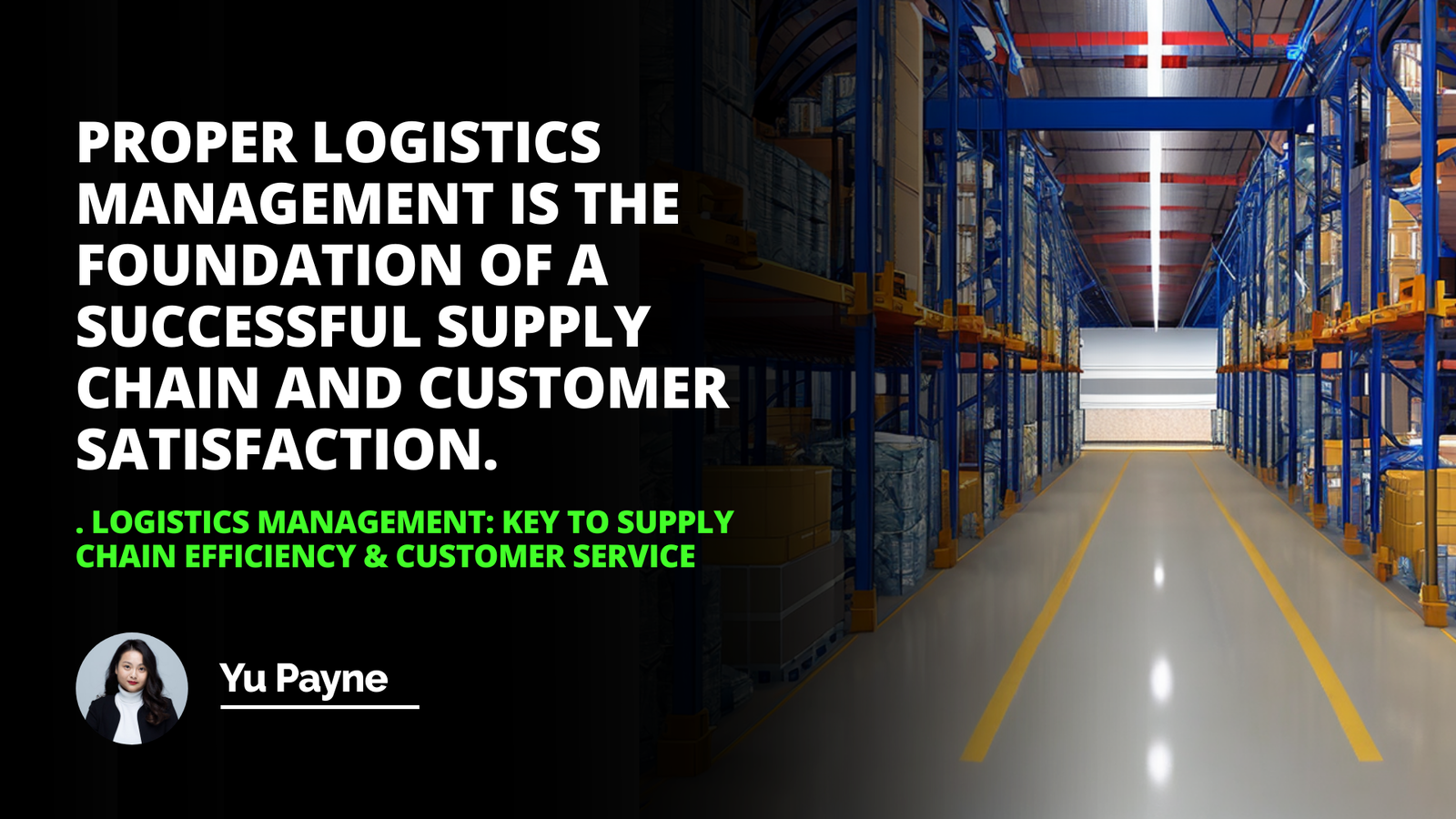
Factors That Affect Productivity
Strategies for Achieving Optimal Service Support
Benefits of Optimal Service Support
Productivity is the output of goods and services per unit of input. It is a critical factor for economies and businesses alike. For a company to remain competitive and profitable, it is essential to sustain high productivity. Optimal service support balances customers' needs with an organization's operational factors to ensure the maximum outcome. It involves developing strategies that promote the organization's goals while providing responsive, quality service support to customers.
Factors That Affect Productivity
The environment in which an organization operates plays an essential role in attaining optimal service support. Factors such as a comfortable, welcoming physical workspace, ideal lighting, and temperature all contribute to a productive atmosphere for employees. Additionally, virtual private networks can enable employees to work more efficiently, resulting in greater productivity.
Time management is essential to achieving optimal service support. Identifying how tasks are completed and making changes to maximize efficiency is crucial. Setting achievable goals and assigning tasks to the right team members can ensure tasks are completed promptly. Additionally, integrating technologies such as project management systems and cloud-based collaboration tools can allow staff to maximize their available hours while completing tasks effectively.
Related Course: Free Time Management Course
Employee engagement is an essential factor in creating productive and motivated staff members. Developing an environment that encourages open communication and feedback, providing recognition and rewards for outstanding performance, offering flexible and targeted training and mentoring programs, establishing a positive workplace culture, and emphasizing employee safety are all strategies that can help foster employee engagement.
Strategies for Achieving Optimal Service Support
Understanding Customer Needs: To achieve optimal service support, understanding and anticipating customer needs is essential. Developing and maintaining customer profiles, conducting customer surveys and focus groups, and providing comprehensive customer service training for staff are all strategies that can help an organization understand customer needs. Additionally, establishing a customer feedback system and monitoring customer interaction data can help an organization identify customer pain points and develop strategies to address them.
Developing an Effective Process: Establishing effective processes is essential to achieving optimal service support. Having a clear understanding of the customer journey, creating repeatable processes, accurately monitoring performance, and prioritizing tasks based on customer needs are all strategies that can help an organization optimize its service support. Additionally, regularly reviewing performance and feedback to identify areas of improvement and providing staff with appropriate training and support can help maximize the effectiveness of the process.
Utilizing Technology: Technology is an essential tool for optimizing service support. Automation can streamline processes and increase efficiency. Using technologies such as chatbots and AI-powered analytics tools can give organizations better insight into customer behavior and help identify areas of improvement. Additionally, integrating CRM and ERP systems can help organizations collect, analyze, and act on customer data to optimize the customer experience.
Benefits of Optimal Service Support
Optimal service support provides several benefits for both customers and the organization. Improved Customers Satisfaction: Once customers' needs have been identified and addressed through effective processes and technologies, it can increase satisfaction and loyalty. Understanding Customer needs and developing strategies to address them can help maintain a positive relationship between the Customer and the organization.
Increased Efficiency: By streamlining processes and utilizing technologies, organizations can increase efficiency and reduce operational costs. Automating processes can save an organization time and help staff members focus on more complex tasks. Effective use of technology can also reduce the amount of administrative work that needs to be completed, leading to increased efficiency.
Enhanced Employee Morale: When staff members are provided with the necessary support and resources to succeed, it can improve morale. This, in turn, can lead to increased loyalty and better job satisfaction among employees. Additionally, providing appropriate recognition and rewards for outstanding performance can further enhance employee morale.
Conclusion: Organizations must understand customer needs, develop effective processes, and utilize available technologies to attain optimal service support and maintain productivity. By doing this, organizations can improve customer satisfaction, increase efficiency, and enhance employee morale. As such, organizations must establish strategies to achieve optimal service support to remain competitive and flourish in an ever-changing business landscape.
The key to providing excellent support is finding ways to keep productivity high.
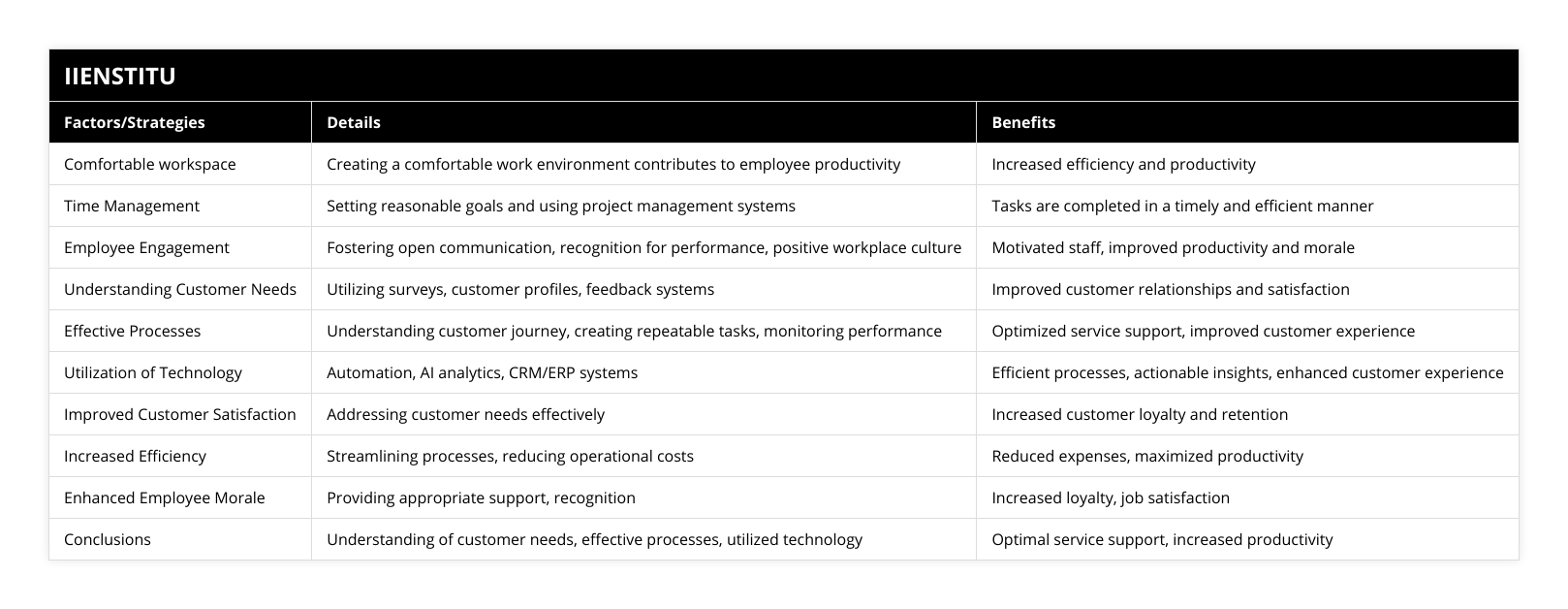
Frequently Asked Questions
How can service support teams maintain productivity while providing high-level customer service?
Examining how service support teams can maintain productivity while providing high-level customer service is integral to running an efficient and successful business. These departments must be run efficiently and productively, as customer service is essential to a customer’s overall experience. Service support teams can use several strategies and techniques to ensure that they provide the highest quality customer service while still keeping productivity levels high.
First and foremost, service support teams should ensure they are equipped with the required tools and resources to provide adequate customer service. This could include, for example, access to a service knowledge base with detailed answers to commonly asked questions, tools to enable efficient task tracking and management, and an organized and automated system for responding to customer inquiries quickly and accurately. Furthermore, these teams should maintain open and transparent lines of communication between their members, enabling quick responses to customer inquiries and increased overall productivity.
In addition, service support teams should also strive to maintain exceptional customer service by clearly understanding their customer’s needs and expectations. This could involve training and implementing strategies such as customer relationship management (CRM) to understand better customer behavior and patterns, as well as providing feedback surveys and listening to customer feedback to improve the customer service experience further.
Finally, service support teams should utilize the latest technologies and software. Numerous software solutions on the market can help streamline customer service processes and increase employee productivity, including data analytics and automation tools. Additionally, these teams should ensure that their systems are regularly updated and that employees can access the latest features and tools.
Overall, service support teams can maintain productivity and provide high-level customer service through careful planning, equipping their teams with the necessary resources and tools, maintaining clear lines of communication between members, understanding customer needs, and utilizing the latest technologies and software. This combination of strategies will ensure that service support teams can deliver exceptional customer service while remaining productive.
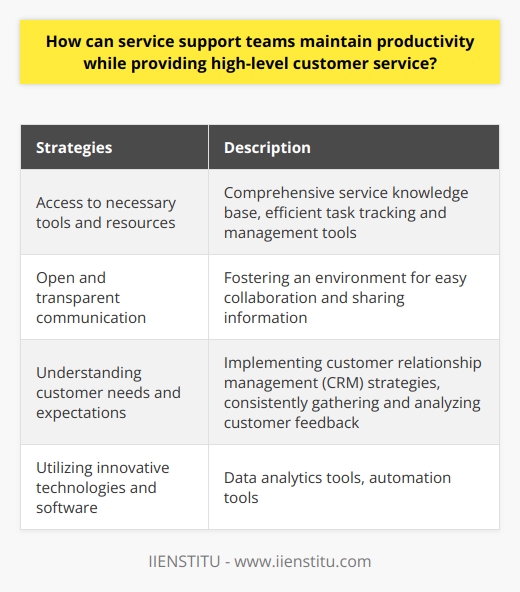
What tips can be used to ensure a professional, consistent tone of voice in service support communications?
Communicating with customers through any service support often encompasses multiple mediums, from text and chat to phone and video. Therefore, maintaining a consistent and professional tone of voice in all communications is essential. This will ensure that employees remain professional and courteous and help strengthen the customer relationship. This article provides tips for maintaining a professional, consistent tone of voice in all service support communications.
First and foremost, creating a consistent message and tone of voice across all mediums is essential. This means that the same style and diction should be used, no matter the medium or the context of the conversation. Clear, concise communication should be prioritized while remaining respectful and courteous. Employees should always strive to create a positive experience for the customer, no matter how challenging the situation may be.
Second, employees should be familiar with the policies and procedures that are specific to the company and apply them evenly to all customers. Third, companies should ensure that all employees who interact with customers understand these policies and that they are used consistently by all customers. Adhering to these set protocols and standards will help to ensure a professional, consistent tone of voice throughout all customer interactions.
Third, employees should strive to maintain a calm and level-headed demeanor while communicating with customers. Employed teams should not take things personally and should remain professional and neutral to create a positive customer experience. Listening to the customer and responding promptly is essential to successful customer service.
Finally, it is essential to be aware of cultural and linguistic differences that may affect the tone of voice used during customer interactions. Employees should be mindful of language barriers or cultural norms and remain respectful and accommodating. Using words and techniques that feel natural to the customer has improved customer satisfaction.
In conclusion, service support communications must maintain a professional and consistent tone of voice. This can be achieved by creating consistent messages, familiarizing employees with company policies, promoting a calm and level-headed demeanor, and being mindful of cultural and linguistic differences. These tips will ensure that all customer interactions remain professional and courteous to create a positive customer experience.
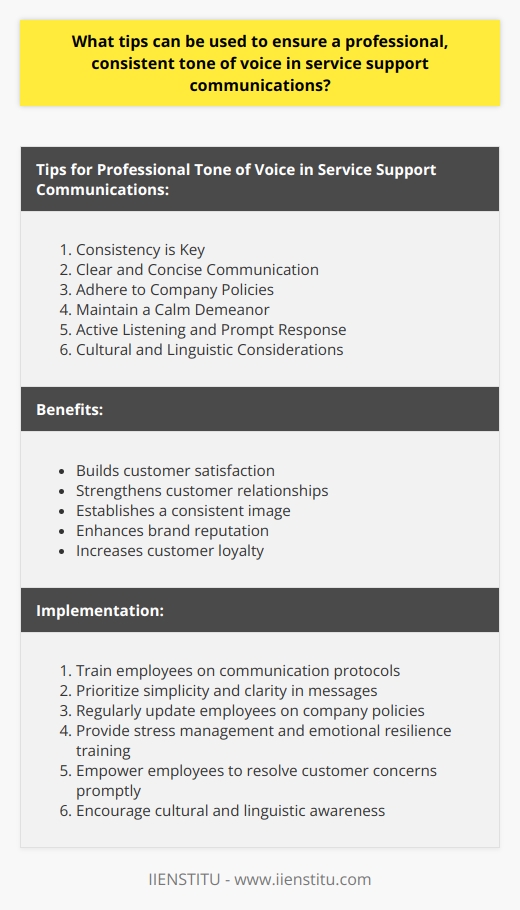
What are the essential elements needed to provide effective and efficient service support?
Providing effective and efficient service support is essential to maintain customer satisfaction and loyalty in any business. Therefore, permission should be tailored to each customer to ensure that their expectations are met and that they are given the best possible experience. To provide a comprehensive and successful support service, certain essential elements should always be considered.
The most important aspect of providing adequate support is the quality of customer interaction. This involves actively listening to customers, responding to their queries, and answering questions courteously and helpfully. Adopting the right attitude and attitude, and understanding the customer’s viewpoint are all essential components of providing a high-quality service. Additionally, clear and concise communication is vital for reliable support.
Moreover, adequate service support also requires an effective problem-resolution process. This process should be designed around speed and accuracy, as customers expect immediate solutions. Effective problem resolution requires technical expertise and careful consideration of the customer’s needs. This requires more than just a knowledge base – a proper analysis of the issue needs to be carried out to guarantee an appropriate solution.
Finally, alignment between customer expectations and delivered results is necessary for effective and efficient service support. Customers should be informed at every stage of the support process and regularly updated on progress. This will ensure that they understand the circumstances and provide assurance that their issues are being addressed. A satisfactory resolution should also be provided, with thoughtful follow-up and feedback mechanisms to ensure the customer’s positive experience.
In conclusion, providing customers with effective and efficient service support is critical to maintaining customer loyalty and satisfaction. The essential elements that should be implemented to ensure successful service support include:
Quality customer interaction.
A streamlined problem-resolution process.
Alignment between customer expectations and results.
With these essential elements, businesses can guarantee their customers a positive experience.
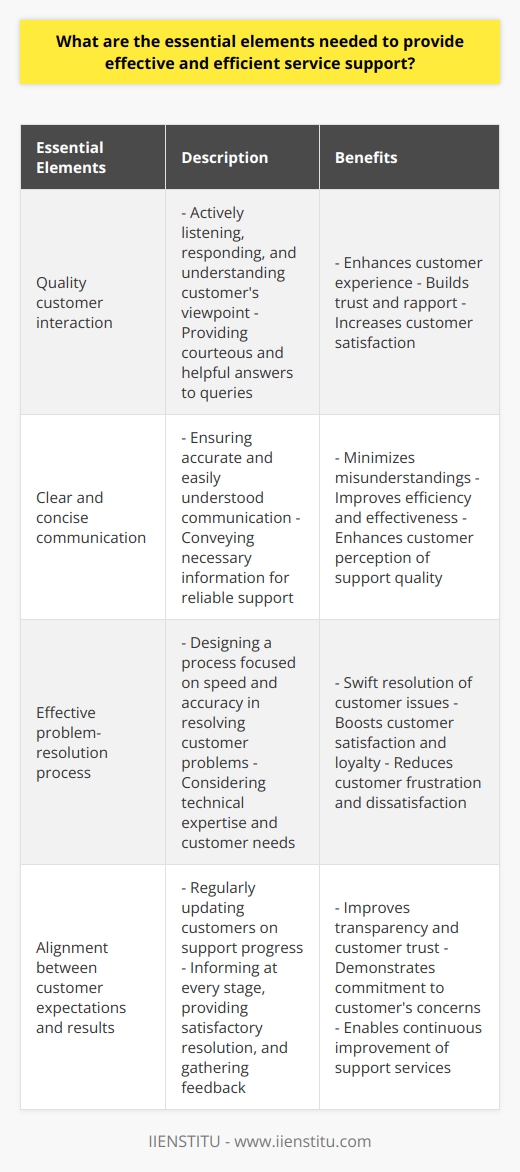
What are the 4 strategies for improving productivity in service and optimizing the quality of service provided?
**Strategy 1: Effective training and skill development**
One essential strategy for improving productivity in service and optimizing the quality of service provided is to invest in effective training and skill development programs for employees. These programs should aim to enhance their skillsets, knowledge, and abilities, enabling them work efficiently and deliver high-quality services to the customers.
**Strategy 2: Streamlining processes and workflow**
Another strategy is to streamline processes and workflow, which entails evaluating the current methods, identifying bottlenecks, and implementing changes to improve efficiency. By reducing redundancies, simplifying tasks, and automating repetitive actions, businesses can increase productivity and improve service quality.
**Strategy 3: Implementing performance measurement and feedback systems**
The third strategy is to implement performance measurement systems and regular feedback mechanisms, which can help in monitoring employee performance and identifying areas for improvement. Through regular assessments and constructive feedback, employees can work on enhancing their skills, which in turn results in improved productivity and service quality.
**Strategy 4: Fostering a culture of continuous improvement**
Finally, fostering a culture of continuous improvement is crucial in maintaining high productivity levels and service quality in the long run. Encouraging employees to share their ideas, suggestions, and best practices, while providing them with tools, resources, and support, can help in driving innovation, achieving operational excellence, and sustaining exceptional customer service.
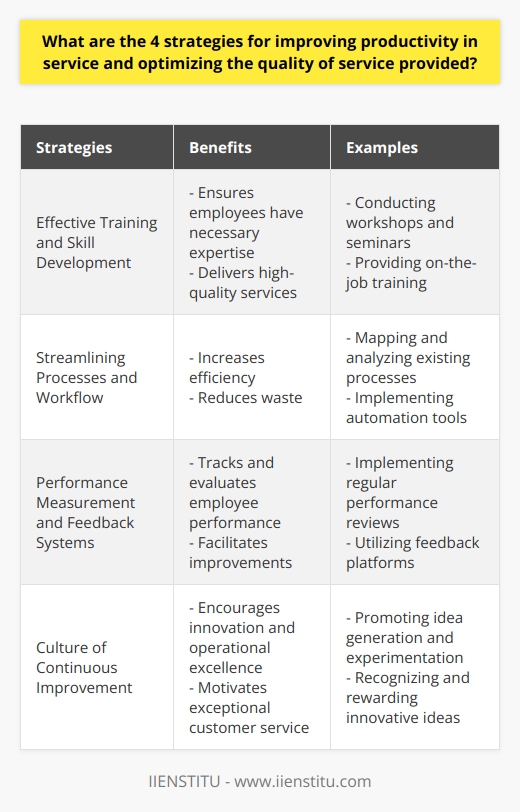
How can high levels of productivity in service support teams be maintained without sacrificing service quality?
Effective Teamwork and Collaboration
To maintain high levels of productivity in service support teams without sacrificing service quality, effective teamwork and collaboration must be prioritized. Open communication channels within the team, as well as with supervisors and management, can facilitate the identification of potential issues and lead to proactive solutions. Regular team meetings can also foster knowledge sharing and skill development among team members.
Continuing Professional Development
Team members should be encouraged to engage in continuing professional development programs to ensure their skills and knowledge remain up-to-date. This can include attending workshops, webinars, and conferences or pursuing additional industry certifications. By consistently honing their abilities and staying informed about industry trends, service support teams can continue providing exceptional service to clients.
Empowerment through Decision-Making
Empowering team members through increased autonomy and decision-making capabilities can lead to increased productivity and overall job satisfaction. When employees feel they have control over their work, they are more motivated to perform at their best. This trust in employees' abilities allows for prompt issue resolution and greater efficiency in service delivery.
Leveraging Technology
The integration of appropriate technology and tools can significantly increase the productivity of service support teams without sacrificing quality. Automated processes can reduce manual workload, allowing team members to focus on more complex tasks that require human intervention. Utilizing advanced technologies such as artificial intelligence, machine learning, and data analytics can further enhance the teams' abilities to deliver high-quality services.
Monitoring and Adjusting Performance
In order to maintain high productivity and quality, regular monitoring and evaluation of the team's performance are essential. Key performance indicators (KPIs) should be established to objectively measure productivity and effectiveness. Periodic reviews of these KPIs can provide valuable insights into areas requiring improvement and facilitate the identification of best practices for the team.
Balancing Workload and Employee Well-being
Lastly, ensuring employees have a balanced workload is crucial in maintaining high productivity and preventing burnout. By taking measures to prevent the excessive workload through efficient resource allocation, management can ensure employees have sufficient time to complete tasks with precision, reducing the risk of fatigue-induced errors. Providing employees with various emotional and mental health support options can also contribute to a healthier and more productive work culture.
In conclusion, fostering effective teamwork, offering opportunities for professional development, empowering employees, leveraging technology, monitoring performance, and balancing workload are essential strategies to maintain high levels of productivity in service support teams without sacrificing service quality.
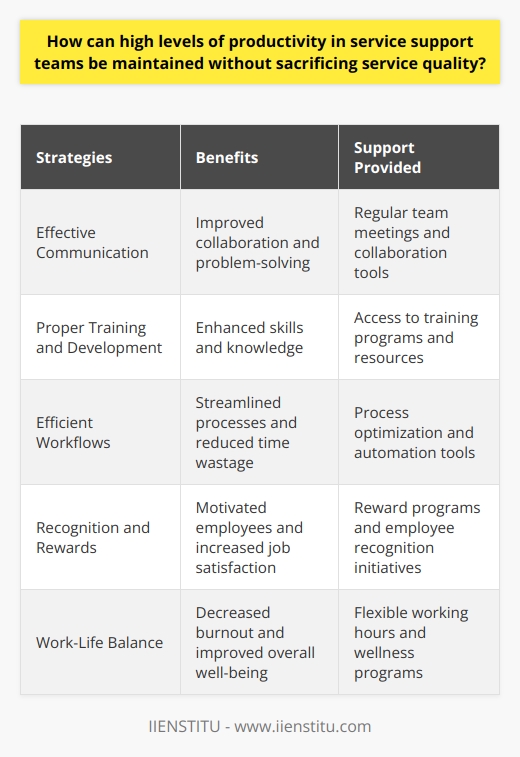
Which strategies can be employed to enhance productivity and ensure a consistent approach to service support tasks?
Optimizing Task Prioritization
One effective strategy to enhance productivity in service support tasks involves the proper prioritization of tasks. By categorizing tasks based on urgency and importance, support teams can focus on addressing high-priority issues first, leading to faster response times and increased customer satisfaction.
Implement Standard Operating Procedures
The development and implementation of Standard Operating Procedures (SOPs) enable a consistent approach to service support tasks. By establishing clear guidelines and processes for resolving common issues, support teams can ensure that they are providing high-quality support to customers in a predictable and standardized manner. Additionally, SOPs can be continuously iterated and improved based on ongoing performance analysis and feedback from customers.
Leverage Automation Tools
Utilizing automation tools can significantly improve the efficiency and consistency of service support tasks. By automating repetitive tasks, such as ticket assignment, support teams can focus on addressing customer inquiries, resulting in faster resolution times and increased productivity. Moreover, the use of AI-powered chatbots can help streamline customer interactions by providing instant answers to frequently asked questions, thereby reducing the workload for support agents.
Encourage Cross-Functional Collaboration
Promoting cross-functional collaboration between support teams and other departments within an organization can lead to better problem-solving capabilities and resource allocation. Through effective communication and regular feedback, support teams can obtain valuable insights from sales, marketing, or engineering teams, and vice versa. This collaborative approach can improve overall productivity by increasing the understanding of customer needs and enabling the development of targeted solutions.
Invest in Training and Development
Lastly, investing in the training and development of support staff is crucial in enhancing productivity and maintaining a consistent approach to service support tasks. Providing employees with access to up-to-date training materials, workshops, and seminars helps them to stay informed about best practices and industry trends. In turn, a well-trained support team will be better equipped to deliver high-quality customer service in a consistent and efficient manner.
In conclusion, the combination of task prioritization, implementation of SOPs, leveraging automation tools, cross-functional collaboration, and investment in training and development culminate in a potent solution for enhancing productivity and ensuring a consistent approach to service support tasks. By adopting these strategies, organizations can effectively improve their support teams' performance and, ultimately, provide a better experience to customers.
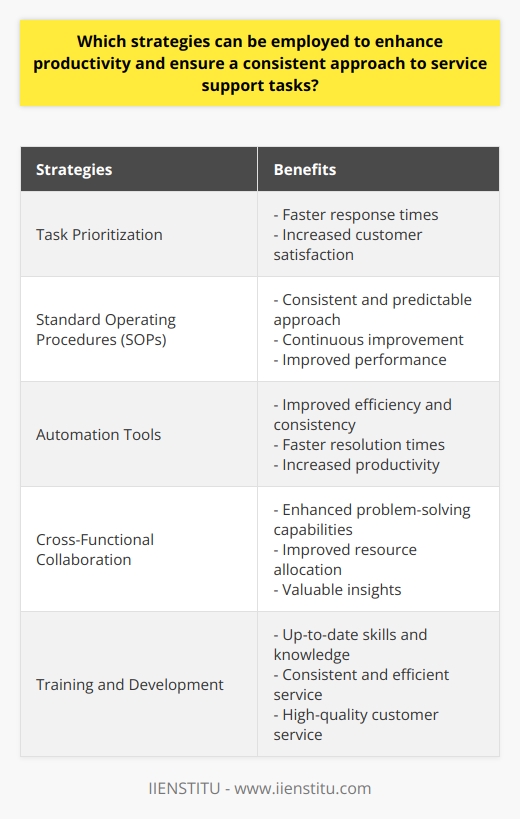
What are the key factors influencing productivity in customer service departments?
Role of Employee Skills and Knowledge
One of the key factors influencing productivity in customer service departments is the skills and knowledge of the employees. Proficient employees who understand industry-specific processes, as well as effective communication techniques, can quickly resolve customer inquiries and issues, thereby contributing to higher productivity.
Impact of Work Environment
The work environment also plays a vital role in the productivity levels of customer service departments. A positive atmosphere, with comfortable working conditions and supportive management, fosters employee motivation and commitment. As a result, service representatives become more efficient and effective in their roles, leading to enhanced productivity.
Importance of Technology
Technological advancements and their integration into the customer service departments can significantly improve productivity. For instance, tools like Customer Relationship Management (CRM) systems, chatbots, and automated workflows streamline communication processes and enable faster response times to customer concerns. Additionally, data analytics aids in identifying patterns and trends allowing for continuous improvement and a more proactive approach to customer service.
Effect of Employee Training
Continuous employee training and development programs play a crucial role in productivity enhancement. Regular training sessions that address new industry trends, products, services, and customer expectations ensure that service representatives are well-equipped to handle varying customer needs effectively.
Role of Organizational Culture
A strong organizational culture that values customer service sets the foundation for a productive service department. When an organization establishes a culture that empowers employees to make decisions and take ownership of customer concerns, they become more engaged and are likely to put in additional effort to resolve issues, resulting in higher productivity.
Significance of Employee Recognition
Incorporating employee recognition and reward programs has a direct impact on the productivity of customer service representatives. Recognizing and appreciating their efforts motivates them to perform better, thus boosting their efficiency and the overall productivity of the department.
In conclusion, the productivity of customer service departments is influenced by a multitude of factors, including employee skills and knowledge, work environment, technology, training, organizational culture, and employee recognition programs. Implementing measures to strengthen these factors can lead to significant improvements in productivity levels, contributing to a more effective and efficient customer service department.
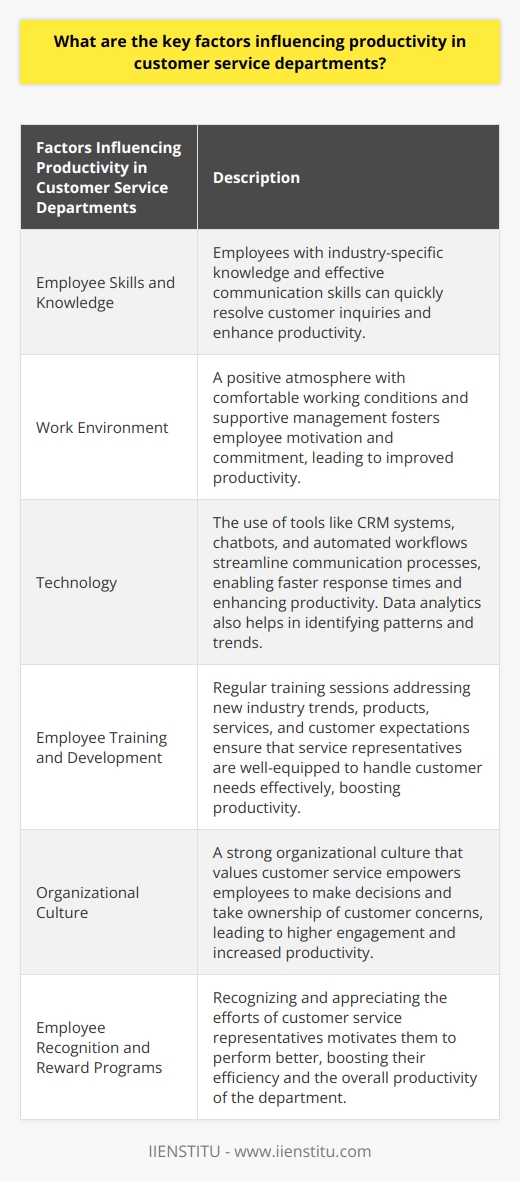
How can technology and automation contribute to enhancing productivity in service industries?
Technology's Role in Productivity Improvement
Technology and automation can significantly enhance productivity in service industries by streamlining processes and reducing manual labor. One key factor in productivity improvement is the use of advanced software and hardware systems that enable businesses to better manage their operations.
Efficiency Through Automation
By implementing automation and robotics in service industries, human error can be minimized. This leads to fewer mistakes and higher efficiency in various tasks, such as inventory management and customer service. Automated systems can reduce the time spent on mundane, repetitive tasks, thus freeing up employees to focus on more important aspects of their job.
Data-Driven Decision Making
The integration of technology in service industries allows for the collection of valuable data that can be used to make well-informed decisions. Analyzing this data can help businesses identify areas for improvement and implement changes that can potentially increase productivity. Furthermore, processes can be optimized and tailored to individual customer needs, leading to enhanced customer satisfaction and increased business opportunities.
Employee Training and Upskilling
Embracing technology and automation in service industries can contribute to workforce upskilling. Employees can be trained to use advanced tools and software programs, thereby equipping them with the skills necessary to stay competitive in a rapidly evolving landscape. Not only does this lead to increased productivity, but it also creates a more marketable and satisfied workforce.
Remote Work Capabilities
The rise of remote work capabilities, made possible through technology, has revolutionized how business is conducted in service industries. Employees can now work from virtually anywhere, thanks to collaboration tools such as video conferencing, project management software, and cloud storage solutions. This has led to reduced overhead costs and increased employee satisfaction, both of which contribute to greater productivity.
Conclusion
In summary, technology and automation serve as powerful catalysts for enhancing productivity in service industries. They play a crucial role in streamlining business operations, improving process efficiency, enabling well-informed decision-making, promoting employee upskilling, and facilitating remote work opportunities. By prioritizing technological integration, service industries can continue to innovate, foster growth, and unlock their full productivity potential.
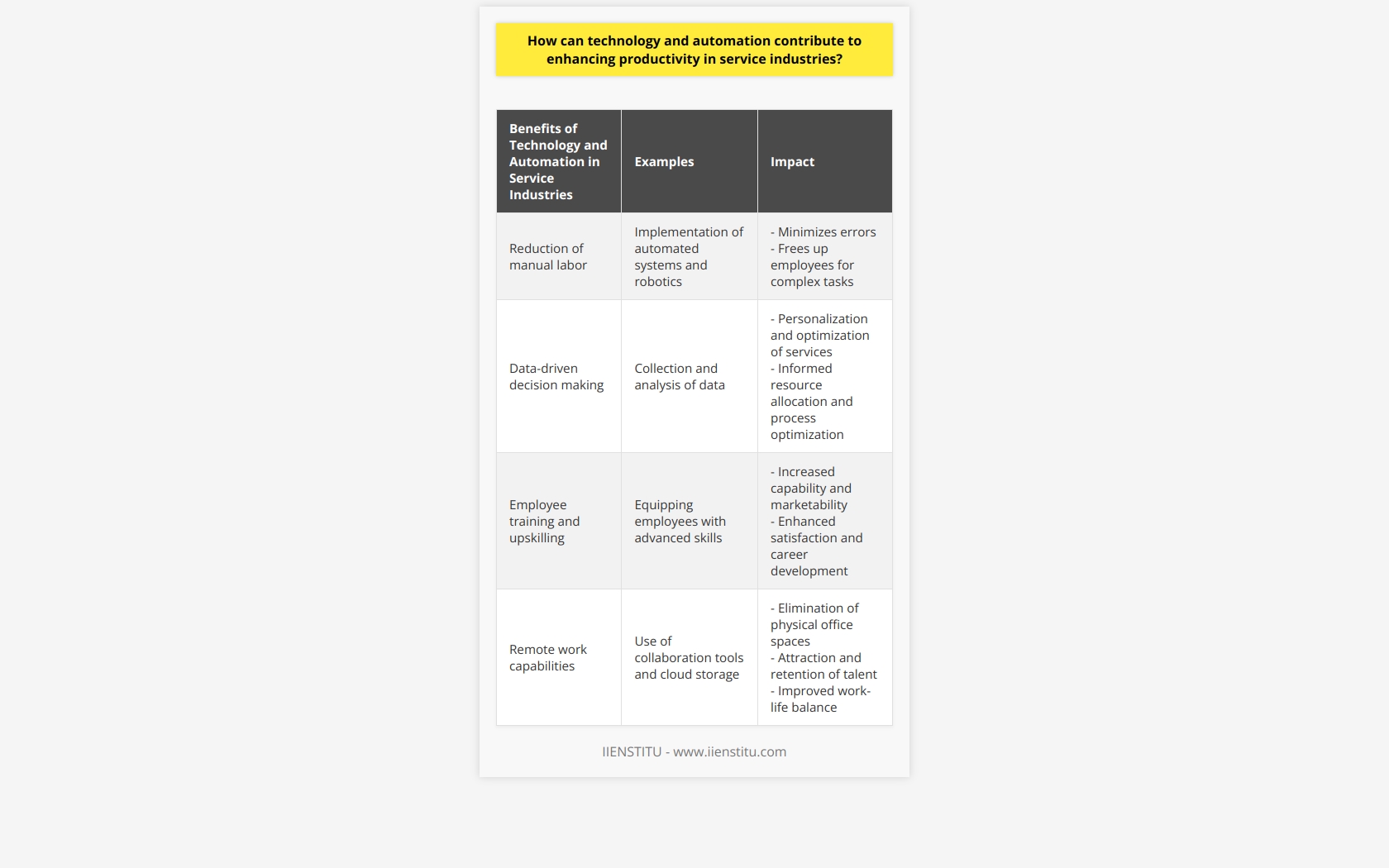
What role does effective communication play in improving the overall productivity of customer service teams?
Role of Effective Communication in Productivity
Effective communication plays a vital role in enhancing the productivity of customer service teams. Effective communication strategies can bridge the gap between customers and team members, allowing teams to priorit.Particularly, it enables teams to understand the needs of their customers and tailor their services accordingly.
Clarity and Conciseness
One critical aspect of effective communication is delivering clear and concise messages. By ensuring that customer service representatives provide accurate information to customers, the chances of misunderstandings decrease, significantly reducing the need for repeat interactions. As a result, the team becomes more efficient and productive.
Active Listening and Empathy
Active listening and empathy also contribute to the effectiveness of customer service teams. These skills enable representatives to comprehend the emotional state of customers, helping them provide targeted solutions. Consequently, satisfied customers are more likely to stay loyal to the company, potentially increasing revenue and team productivity.
Cross-functional Collaboration
Effective communication is not only crucial for interacting with customers but also for collaborating within the organization. Efficient information sharing among team members and interdepartmental communication fosters a seamless working environment, leading to faster resolutions of customer queries. Consequently, it elevates the overall productivity of the customer service team.
Issue Resolution
Effective communication also plays a part in speeding up issue resolution times. By adopting communication strategies that facilitate the easy transfer of information between customers and support teams, service teams can quickly identify solutions and resolve customer issues. This efficiency further increases the overall productivity of support staff.
Training and Development
Lastly, investing in training and development of communication skills for customer service teams can contribute to improved productivity. Equipping teams with effective communication strategies can foster strong customer-service team rapport, boosting job satisfaction. This consequent increase in morale and job satisfaction can lead to higher levels of productivity among customer service representatives.
In conclusion, effective communication is essential to customer service team productivity. Clear and concise messaging, coupled with active listening and empathy, fosters a better understanding of customers, improving their satisfaction and loyalty. Also, seamless cross-functional collaboration, faster issue resolution, and regular communication skills training can collectively contribute to optimizing customer service team productivity.


